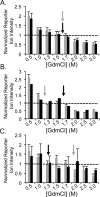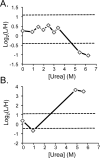Discovery of Manassantin A Protein Targets Using Large-Scale Protein Folding and Stability Measurements
- PMID: 27322910
- PMCID: PMC5270646
- DOI: 10.1021/acs.jproteome.6b00237
Discovery of Manassantin A Protein Targets Using Large-Scale Protein Folding and Stability Measurements
Abstract
Manassantin A is a natural product that has been shown to have anticancer activity in cell-based assays, but has a largely unknown mode-of-action. Described here is the use of two different energetics-based approaches to identify protein targets of manassantin A. Using the stability of proteins from rates of oxidation technique with an isobaric mass tagging strategy (iTRAQ-SPROX) and the pulse proteolysis technique with a stable isotope labeling with amino acids in cell culture strategy (SILAC-PP), over 1000 proteins in a MDA-MB-231 cell lysate grown under hypoxic conditions were assayed for manassantin A interactions (both direct and indirect). A total of 28 protein hits were identified with manassantin A-induced thermodynamic stability changes. Two of the protein hits (filamin A and elongation factor 1α) were identified using both experimental approaches. The remaining 26 hit proteins were only assayed in either the iTRAQ-SPROX or the SILAC-PP experiment. The 28 potential protein targets of manassantin A identified here provide new experimental avenues along which to explore the molecular basis of manassantin A's mode of action. The current work also represents the first application iTRAQ-SPROX and SILAC-PP to the large-scale analysis of protein-ligand binding interactions involving a potential anticancer drug with an unknown mode-of-action.
Keywords: Filamin A; MDA-MB-231; Manassantin A; SILAC; SPROX; cancer; chemical denaturation; elongation factor 1α; iTRAQ; mass spectrometry; mode-of-action; proteomics; pulse proteolysis.
Figures





Similar articles
-
Characterization of the Saccharomyces cerevisiae ATP-Interactome using the iTRAQ-SPROX Technique.J Am Soc Mass Spectrom. 2016 Feb;27(2):233-43. doi: 10.1007/s13361-015-1290-z. Epub 2015 Nov 3. J Am Soc Mass Spectrom. 2016. PMID: 26530046
-
Discovery of Tamoxifen and N-Desmethyl Tamoxifen Protein Targets in MCF-7 Cells Using Large-Scale Protein Folding and Stability Measurements.J Proteome Res. 2017 Nov 3;16(11):4073-4085. doi: 10.1021/acs.jproteome.7b00442. Epub 2017 Oct 11. J Proteome Res. 2017. PMID: 28927269 Free PMC article.
-
SILAC-pulse proteolysis: A mass spectrometry-based method for discovery and cross-validation in proteome-wide studies of ligand binding.J Am Soc Mass Spectrom. 2014 Dec;25(12):2073-83. doi: 10.1007/s13361-014-0992-y. Epub 2014 Oct 15. J Am Soc Mass Spectrom. 2014. PMID: 25315461
-
Energetics-based methods for protein folding and stability measurements.Annu Rev Anal Chem (Palo Alto Calif). 2014;7:209-28. doi: 10.1146/annurev-anchem-071213-020024. Epub 2014 May 28. Annu Rev Anal Chem (Palo Alto Calif). 2014. PMID: 24896313 Review.
-
Proteome-Wide Structural Biology: An Emerging Field for the Structural Analysis of Proteins on the Proteomic Scale.J Proteome Res. 2018 Nov 2;17(11):3614-3627. doi: 10.1021/acs.jproteome.8b00341. Epub 2018 Oct 8. J Proteome Res. 2018. PMID: 30222357 Free PMC article. Review.
Cited by
-
Target identification of small molecules: an overview of the current applications in drug discovery.BMC Biotechnol. 2023 Oct 10;23(1):44. doi: 10.1186/s12896-023-00815-4. BMC Biotechnol. 2023. PMID: 37817108 Free PMC article. Review.
-
Chemoproteomics for Plasmodium Parasite Drug Target Discovery.Chembiochem. 2021 Aug 17;22(16):2591-2599. doi: 10.1002/cbic.202100155. Epub 2021 Jun 10. Chembiochem. 2021. PMID: 33999499 Free PMC article. Review.
-
Benzoxanthenone Lignans Related to Carpanone, Polemanone, and Sauchinone: Natural Origin, Chemical Syntheses, and Pharmacological Properties.Molecules. 2025 Apr 10;30(8):1696. doi: 10.3390/molecules30081696. Molecules. 2025. PMID: 40333626 Free PMC article. Review.
-
Recent advances in identifying protein targets of bioactive natural products.Heliyon. 2024 Jun 29;10(13):e33917. doi: 10.1016/j.heliyon.2024.e33917. eCollection 2024 Jul 15. Heliyon. 2024. PMID: 39091937 Free PMC article. Review.
-
Currently Available Strategies for Target Identification of Bioactive Natural Products.Front Chem. 2021 Sep 30;9:761609. doi: 10.3389/fchem.2021.761609. eCollection 2021. Front Chem. 2021. PMID: 34660543 Free PMC article. Review.
References
-
- Song SY, Lee I, Park C, Lee H, Hahm JC, Kang WK. Neolignans from Saururus chinensis inhibit PC-3 prostate cancer cell growth via apoptosis and senescence-like mechanisms. Int J Mol Med. 2005;16(4):517–23. - PubMed
-
- Rao KV, Alvarez FM. Manassantins a/B and Saucerneol - Novel Biologically-Active Lignoids from Saururus-Cernuus. Tetrahedron Lett. 1983;24(45):4947–4950.
-
- Hodges TW, Hossain CF, Kim YP, Zhou YD, Nagle DG. Molecular-targeted antitumor agents: The Saururus cernuus dineolignans manassantin B and 4-O-demethylmanassantin B are potent inhibitors of hypoxia-activated HIF-1. J Nat Prod. 2004;67(5):767–771. - PubMed
-
- Seo CS, Lee WH, Chung HW, Chang EJ, Lee SH, Jahng Y, Hwang BY, Son JK, Han SB, Kim Y. Manassantin A and B from Saururus chinensis inhibiting cellular melanin production. Phytother Res. 2009;23(11):1531–6. - PubMed
Publication types
MeSH terms
Substances
Grants and funding
LinkOut - more resources
Full Text Sources
Other Literature Sources
Molecular Biology Databases
Miscellaneous

